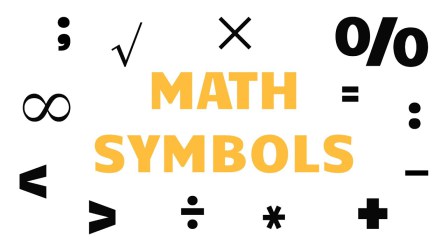Math Symbols

Math is all about numbers, symbols, and formulas. Math symbols[1] are used for different purposes from one mathematical field to another. Using symbols to represent mathematical information makes it easier to understand expressions as these symbols show the relationship between quantities. Let us look at the common ones that we use across different branches of mathematics.
Common Math Symbols
We have at least 10,000+ symbols and there are some that we rarely use. The most common symbols are listed in the following table:
Symbols | Meaning | Math Symbols Examples |
+ | Add | 5 + 4 = 9 |
- | Subtract | 5 - 4 = 1 |
= | Equal to | 1+1 = 2 |
≡ | Identically equal to | (a+b)2≡ a2 + 2ab +b2 |
≈ | Approximately equal to | Π ≈ 3.14 |
≠ | Not equal to | 5 + 4 ≠ 1 |
× | Multiply | 5 × 4 = 20 |
÷ | Divide | 10 ÷ 2 = 5 |
x,y | Variables | x=5, y=2 |
√ | Square root | √4=2 |
3√x | Cube root of x | 3√27=3 |
n√x | nth root of x | 4√16=2 |
() | Parentheses | 2+(5-3)=2+2=4 |
∈ | Belongs to | 0 ∈ Whole number |
∉ | Does not belong to | 1/2∉ Natural numbers |
∴ | Therefore | x+1=2∴ x=1 |
∵ | Because | 1/2÷0.5=1(∵1/2=0.5) |
∞ | Infinity | Infinity is countless, 1/3 when written in decimal form, is endless 0.333..... |
! | Factorial | 5! =5×4×3×2×1 |
Math Symbols Used in Logic
The following table shows the math symbols used in logic.
Symbols | Meaning | Math Symbols Examples |
∃ | There exists at least one | ∃ x: P(x)∃ x: F(x) There exists at least one element of p(x), x, such that F(x) is True. |
∃! | There exists one and only one | ∃! x: F(x) means that there is exactly one x such that F(x) is true. |
∀ | For all | ∀n>1; n2>1 |
¬ | Logical Not | Statement A is true only if ¬ is false x≠y⟺¬(x=y) |
∨ | Logical OR | The statement A ∨ B is true if A or B is true; if both are false, the statement is false. |
𝖠 | Logical And | The statement A 𝖠B is true if A and B are both true; else it is false. |
⟹ | Implies | x = 2 ⟹ x2 = 4 |
⟺ | If and only if | x +1 = y +1 ⟺ x = y |






